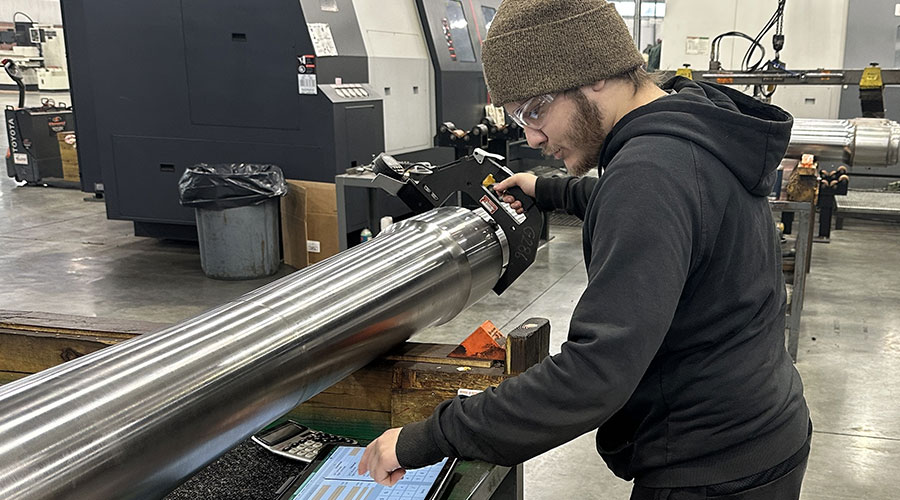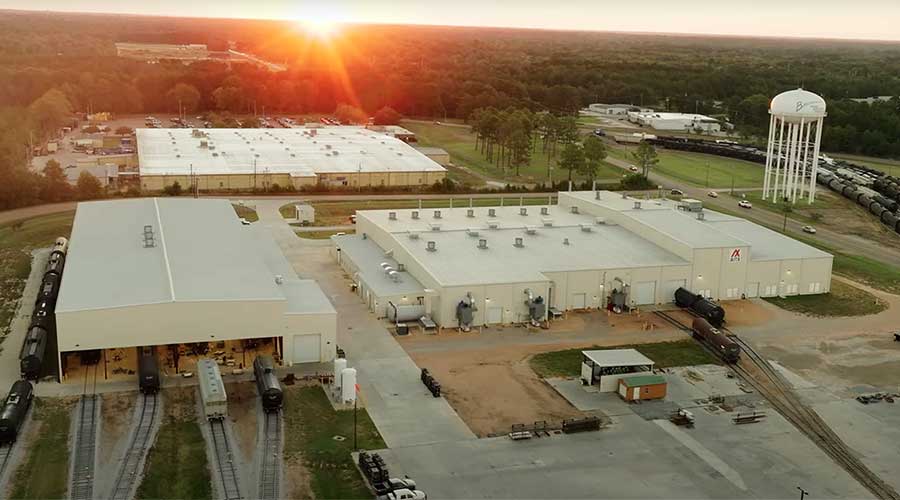Stay updated on news, articles and information for the rail industry
October 2007
Rail News: Mechanical
Intermodal car rebound on order
By Jeff Stagl, Managing Editor
The number of orders left on intermodal car builders’ books can be counted on one hand — or more specifically, one finger. By year’s end, Canadian National Railway Co. will take delivery of 1,700 double-stack platforms from The Greenbrier Cos. The Class I placed the order in May.
The only other intermodal car purchases of note this year can be tallied with two fingers. BNSF Railway Co. obtained a small number of 40-foot wells from Greenbrier as part of a multi-year contract and TTX Co. added a few wells to its 107,000-car fleet.
Based on this year’s purchases and remaining units from prior orders, builders expect to produce about 6,000 wells in 2007 compared with 8,000 in 2006 and 16,000 in 2005.
One look at the Association of American Railroads’ weekly traffic reports and it’s easy to determine why. Through 2007’s first 37 weeks, U.S. and Canadian railroads’ cumulative intermodal volume totaled 10.2 million trailers and containers, representing a 1.2 percent decrease compared with traffic during the same 2006 period.
Asian imports have declined at West Coast ports, delivering the biggest traffic blow since international containers account for 70 percent of railroads’ intermodal volume. In addition, consumer spending and housing starts are down, meaning railroads are moving less furniture, kitchen appliances and containerized goods.
“Retail sales and imports drive intermodal,” says Toby Kolstad, a Progressive Railroading columnist and principal at Rail Theory Forecasts L.L.C., which projects North American freight-rail traffic and rail-car demand. “Retail sales are up slightly, but not enough to generate additional traffic.”
The age of intermodal fleets is creeping up, too, but not enough to generate car orders. Most platforms and wells were built since 1985, so fleet owners don’t believe there’s a compelling need to replace equipment, says Kolstad.
So, builders are trying to cope with what figures to be only the fourth year since 1991 that the intermodal industry fails to register volume growth. But they don’t expect assembly lines to remain idle for long.
Asian imports and housing starts likely will turn around - perhaps in 2008’s second quarter - and consumer spending might pick up next year, builders say. If those projections hold true, well production would increase to 8,000 units in 2008, 9,000 units in 2009 and 10,000 units in 2010.
Peaks and valleys
When market conditions do turn, the intermodal industry tends to bounce back quickly, says Patrick Casey, vice president of fleet management for TTX, which manages a free-running pool of more than 210,000 freight cars and is owned by North America’s nine largest railroads.
This year’s fall peak could be a starting bounce-back point. Don’t believe the pundits that say there won’t be one, says Casey. (For more fall peak projections, see Industry News)
“We will see a peak. It just won’t be as sharp as we’d like,” he says.
“In the long run, we will see growth in intermodal business. But there’s still some legs left to the slow period.”
Because of sluggish demand, TTX has placed a higher-than-normal number of intermodal cars in storage this year, says Casey, declining to provide a figure. The company also acquired fewer cars than in years past and currently has no plans to order any more.
A small number of intermodal cars have registered a few more turns this year because railroads used the equipment for other purposes, such as to move automobiles or pipe, says Casey.
Likewise, car builders have found an alternative role for lightly used 48-foot platforms. They’ve implemented programs to cut down the 48 footers to 40-foot platforms.
In June, Greenbrier obtained orders from two customers to cut down 2,500 double-stack platforms to 40-footers. The company expects to complete the order in early 2008.
“Demand is up for 40-footers as railroads run out of line capacity,” says Bob Yates, Greenbrier’s VP of intermodal and automotive.
Greenbrier also offers two cars that can accommodate 40-foot containers: the Maxi-Stack IV, a three-unit articulated double-stack car that can handle 20- to 53-foot-long containers in the well and 40- to 57-foot containers in the top position; and the Maxi-Stack I, a five-unit car that can carry 20- or 40-foot containers in the well and 40- to 53-foot containers in the top position.
Currently, Greenbrier produces 40-foot models and “virtually no” 48- or 53-foot cars, says Yates.
At Trinity Industries Inc.’s TrinityRail subsidiary, production has slowed for its 40-foot, five-unit and 53-foot, three-unit articulated well cars, and 53-foot standalone well car.
The builder hasn’t been a significant player in the intermodal car market of late, says TrinityRail Senior VP of Business Development Robert Hulick.
“But we want to be a part of it,” he says. “Intermodal is still a long-term growth market.”
Dyna-might
FreightCar America Inc. is trying to become a bigger player in the market, too. To make it happen, the company will introduce an intermodal car early next year.
For the past 18 months, FreightCar America has been developing the five-unit articulated DynaStack™ car, which is designed to hold 20- or 40-foot containers in its wells. Currently being tested at the Transportation Technology Center Inc. in Pueblo, Colo., the car should enter the field testing stage by year’s end, says Ed Whalen, FreightCar America SVP of Marketing and Sales.
“The timing is good because demand is down now but the cycle should begin turning around about the time we’re ready to take orders in the first quarter,” he says.
In the late 1980s and early 1990s, 89-foot intermodal cars and spine cars accounted for half of FreightCar America’s production. Now, the builder - which currently markets standalone 20- and 40-foot models - produces few intermodal cars, says Whalen.
“We’ll be more diversified because we’re already into coal cars and covered hoppers, which are big, and the next logical segment is intermodal,” he says. “The DynaStack isn’t a ‘me, too’ product. We’re bringing something of value to the marketplace.”
Wabash National L.P. officials feel the same way about the RoadRailer®, a dual-mode trailer the company has marketed since 1980. RoadRailers feature rubber tires for highway moves and bogies for rail travel, as well as air-ride and rail brake systems.
Norfolk Southern Corp. subsidiary Triple Crown Services, Wabash National’s largest RoadRailer customer, hasn’t purchased the trailers for several years.
But Triple Crown recently placed an order for 1,500 units to be delivered over the next three years because the company is registering growth in its shorter intermodal lanes and not competing against long-haul, double-stack traffic, says Lawrence Gross, owner of Gross Transportation Consulting Inc., which distributes RoadRailers for Wabash National.
“They’re up against trucks in the medium and short length-of-haul markets,” he says.
Wabash National also is pursuing more international RoadRailer customers. Last month, the company granted a license agreement to Kirloskar Pneumatic Co. Ltd. to produce and market RoadRailer products in India.
“Nations that don’t have highly developed intermodal infrastructure are good candidates,” says Gross.
Meanwhile, RailRunner N.A. Inc. has lined up the first North American customer for its highway/rail intermodal equipment. Last month, North Star Rail Intermodal L.L.C. (NSRI) began moving agricultural products using RailRunner’s Terminal Anywhere™ container-based intermodal transport system, which features quick-change chassis and bogies.
By truck or train
RailRunner recently delivered 66 chassis and 48 bogies to NSRI, which will use the equipment to move containers via the highway from farmers, processors and ethanol producers to its Montevideo, Minn., terminal; and via the Twin Cities & Western Railroad Co. from the terminal to Minneapolis. Canadian Pacific Railway then will move containers from Minneapolis to Montreal and Vancouver, British Columbia.
The Terminal Anywhere system is targeted at the short-haul (800 miles or less) intermodal market and three containerized freight segments: grain and ethanol-related products, municipal solid waste and inland ports. Potential customers are small shippers, logistics providers or warehousing firms that don’t want to invest a lot of capital to access traditional intermodal service, says RailRunner President and Chief Executive Officer Charles Foskett.
“We don’t compete with existing intermodal networks,” he says. “We’re trying to show that the entry levels to intermodal are lower.”
Railroads certainly can use any traffic pick-me-up RailRunner or others can help generate. A boost in containers and trailers also would speak volumes for intermodal car builders’ business prospects.
“If traffic goes up 5 percent, the industry would need another 7,500 wells and 15,000 platforms,” says Rail Theory Forecasts’ Kolstad. “And that doubles if traffic goes up 10 percent.” 


 2025 MOW Spending Report: Passenger-rail programs
2025 MOW Spending Report: Passenger-rail programs
 Gardner steps down as Amtrak CEO
Gardner steps down as Amtrak CEO
 Guest comment: Oliver Wyman’s David Hunt
Guest comment: Oliver Wyman’s David Hunt
 Women of Influence in Rail eBook
Women of Influence in Rail eBook
 railPrime
railPrime







